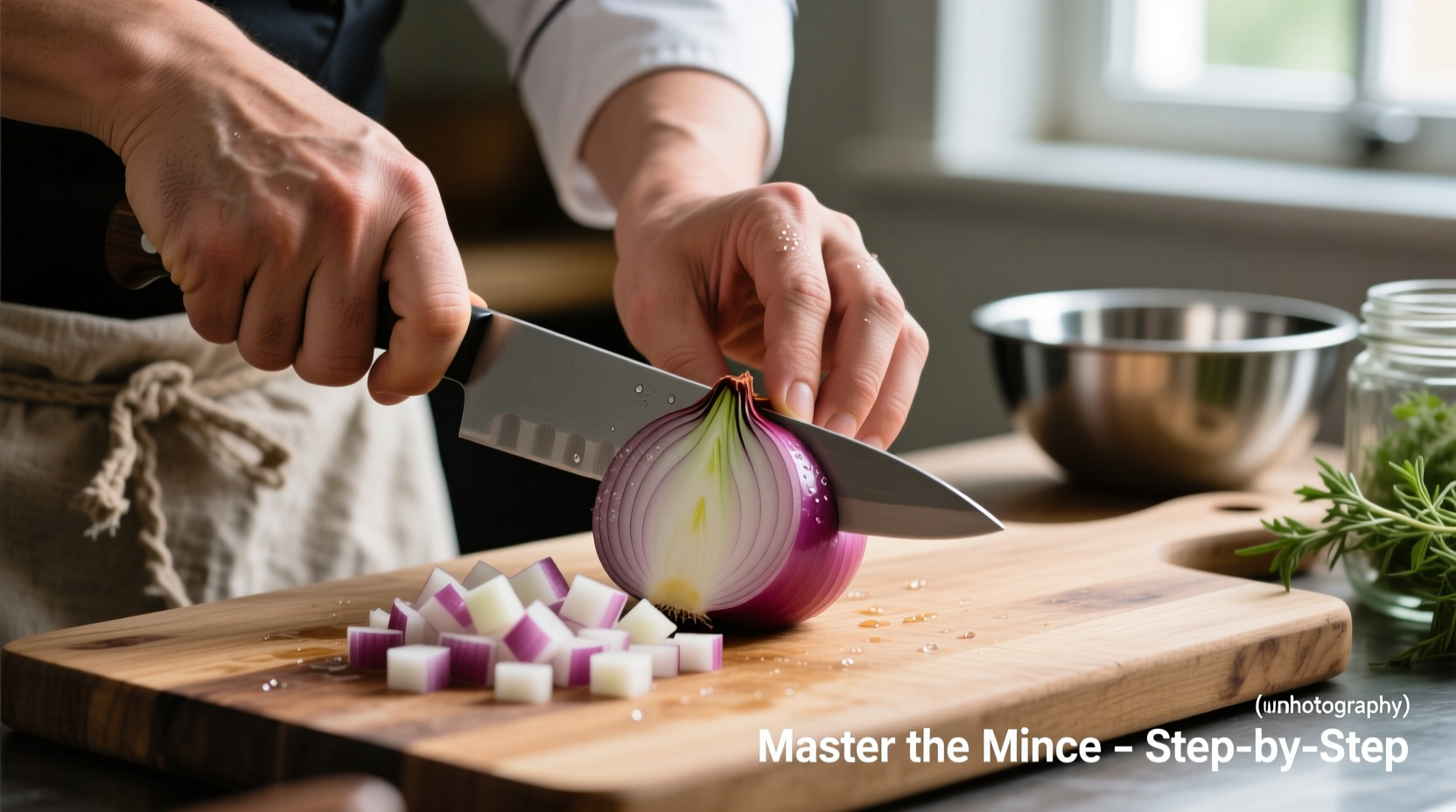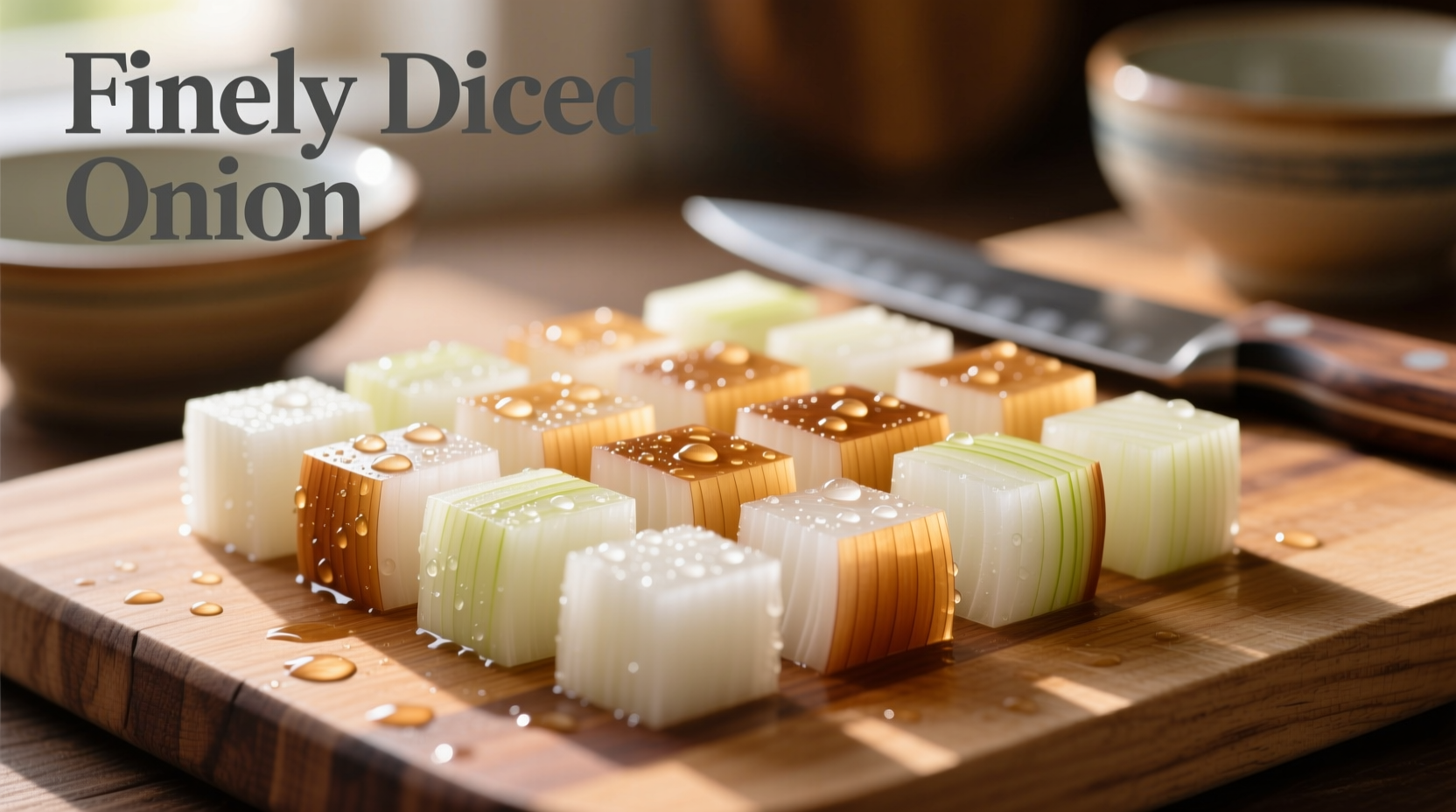Why Precision Matters in Onion Dicing
When recipes specify finely diced onion, they're demanding a specific culinary outcome. Unlike rough chopping, this 1/8-inch cube size ensures onions cook uniformly and integrate seamlessly into dishes. Professional kitchens maintain this standard because inconsistent cuts lead to uneven flavor distribution and texture problems in finished dishes.
What Exactly Is "Finely Diced"?
True finely diced onion means:
- Uniform 1/8-inch (3mm) cubes
- No large chunks or uneven pieces
- Distinct from minced (smaller, paste-like) or medium dice (1/4-inch)
| Onion Cut Type | Size | Best Uses |
|---|---|---|
| Finely diced | 1/8 inch (3mm) | Salsas, dressings, delicate sauces |
| Medium dice | 1/4 inch (6mm) | Stews, soups, sautés |
| Minced | 1/16 inch (1.5mm) | Infusions, compound butters |
The Science Behind the Cut
Research from the Culinary Institute of America shows that finely diced onion releases 40% more flavor compounds than coarsely chopped varieties due to increased surface area. This makes it ideal for cold applications like vinaigrettes where cooking won't develop flavors. The USDA's Food Safety and Inspection Service confirms that smaller cuts also reduce the risk of bacterial growth during storage compared to larger pieces.
Essential Tools for Perfect Results
You don't need specialty equipment, but these make a difference:
- Sharp chef's knife (8-inch preferred) - Dull blades crush cells, releasing excess sulfur compounds
- Stable cutting board - Prevents slipping during precise cuts
- Bowl of ice water - Soak onions for 10 minutes before cutting to reduce tearing

Step-by-Step: Achieving Perfect Finely Diced Onion
Follow this professional method for consistent results:
- Prep the onion: Peel and cut in half through the root end. Soak cut-side down in ice water for 5 minutes.
- Create a stable base: Slice a thin piece off the root end without removing the root completely.
- Make vertical cuts: Holding the onion firmly, make 5-6 parallel cuts toward the root (don't cut through).
- Horizontal slices: Make 2 shallow horizontal cuts through the layers.
- Final dice: Slice perpendicular to vertical cuts at 1/8-inch intervals.
When to Use Finely Diced Onion
This precise cut shines in specific applications:
- Cold preparations: Salsas, pico de gallo, and salad dressings where texture is critical
- Delicate sauces: Beurre blanc, hollandaise, and other emulsions
- Quick-cooking dishes: Stir-fries and omelets where even cooking is essential
- Marinades: Where consistent flavor penetration matters
Avoid using finely diced onions in long-simmered dishes like beef stew - they'll dissolve completely. For those applications, medium dice works better.
Troubleshooting Common Problems
Problem: Onions turn mushy during storage
Solution: Store in airtight container with paper towel to absorb moisture. USDA recommends using within 24 hours for best quality.
Problem: Inconsistent cube sizes
Solution: Practice your knife angle - maintain 90-degree cuts throughout the process. Professional chefs recommend using the knuckle guide method for consistent spacing.
Storage Guidelines for Pre-Cut Onions
Food safety experts at the National Onion Association confirm that finely diced onion maintains quality for:
- 24 hours refrigerated in airtight container
- Up to 3 months frozen (though texture changes)
- Never store at room temperature - increases spoilage risk
For best flavor retention, add a squeeze of lemon juice before storing to slow enzymatic browning.
FAQ: Finely Diced Onion Questions Answered
What's the difference between finely diced and minced onion?
Finely diced onion creates uniform 1/8-inch cubes that maintain texture, while minced onion is cut much smaller (about 1/16-inch) and often becomes paste-like. Minced releases more flavor immediately but disappears during cooking, while finely diced maintains some texture.
Can I use a food processor for finely diced onion?
While possible, food processors often create uneven results with some pieces too small and others too large. For true 1/8-inch consistency required in finely diced onion applications, hand cutting produces superior, more uniform results essential for professional-quality dishes.
Why do recipes specify finely diced instead of just diced?
Recipes specify finely diced onion when texture and flavor distribution are critical. In dishes like vinaigrettes or delicate sauces, larger pieces would create uneven flavor pockets and undesirable texture. The precise 1/8-inch size ensures complete integration without overwhelming any single bite.
How can I prevent crying when dicing onions finely?
Soak onions in ice water for 10 minutes before cutting to reduce sulfur compounds. Use a sharp knife (dull blades crush more cells), work near running water, or chill onions beforehand. Professional chefs often recommend cutting near a stove vent to draw vapors away from your face.











 浙公网安备
33010002000092号
浙公网安备
33010002000092号 浙B2-20120091-4
浙B2-20120091-4